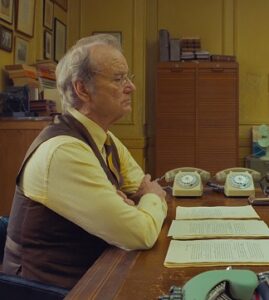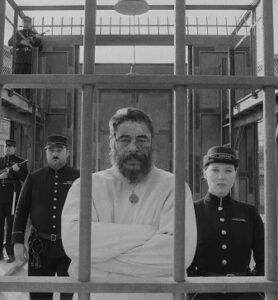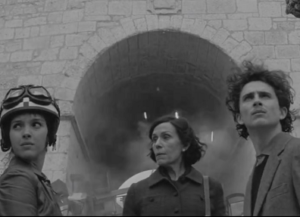The French Dispatch
 Wes Anderson films possess certain commonalities. They’re all light and breezy. The characters are two-dimensional, at best. And everything that happens is in service of the plot (as opposed to character development, exploration of setting, etc.). His plot-driven narratives are funny and cute. And we all leave the theatre in a good mood.
Wes Anderson films possess certain commonalities. They’re all light and breezy. The characters are two-dimensional, at best. And everything that happens is in service of the plot (as opposed to character development, exploration of setting, etc.). His plot-driven narratives are funny and cute. And we all leave the theatre in a good mood.
Best previous effort
Anderson’s best film to date (and the one with which most of us are familiar) is 2014’s “The Grand Budapest Hotel,” in which Ralph Fiennes plays a hotelier mentoring young Tony Revolori, when he’s framed for murder amid the backdrop of an encroaching fascist regime. The large-cast comedy was well-received by critics and the public. And while light as a feather, the extravagant set pieces and certain dialogue has resonated over the years.
 Upping the ante
Upping the ante
Now Anderson has upped the ante with his latest – another large-cast comedic romp called “The French Dispatch,” about the French foreign bureau of a high-brow Kansas periodical. Paying homage to the great journalistic publications which rose to prominence during the 1920s (such as “The New Yorker”), Anderson’s film is a tribute to the art of journalism. Many up-and-coming writers would vie for space amongst these weeklies and monthlies – hoping to have their work placed before a public with increasing time to allot for reading. Writers such as James Baldwin and James Thurber first received recognition in this fashion.
The film’s structure
The fictional French Dispatch is edited by Anderson regular Bill Murray, who compiles what will be the publication’s final issue. This structure allows the film to be divided into three separate stories – a la the Coen Brothers’ recent Western anthology “The Ballad of Buster Scruggs.” As each writer narrates his or her own story, we imagine Murray’s character poring over the submissions with a fine-tooth comb.
Prologue
First, Owen Wilson plays a travel writer who introduces us to the fictional city of Ennui-sur-Blasé, where all our action will take place. This humorous intro piece is not one of the three stories, but it establishes the tone of the film. As in each of the pieces that follow, the writing soars above the material. In fact, most Anderson characters speak above their places in society – just as do the Coen Brothers’ characters. Only in an Anderson or Coen film are we likely to find eloquent hardened criminals.
 First vignette
First vignette
Which brings us to our first vignette – the story of a man (Benicio del Toro) serving a life sentence for a brutal murder, who just so happens to be an accomplished painter and artist. Discovered by an art dealer played by another Anderson regular, Adrian Brody, the artist teeters a fine line between brilliance and complete mental instability. It’s difficult to cite various actors for their work in Anderson’s films as they exist merely in support of the script. But kudos to del Toro, who plays perhaps the film’s most difficult role with a reverent equanimity.
If you remember nothing else of “The French Dispatch,” it will be del Toro painting his muse, played by French actress Lea Seydoux. She first appears cold and calculating, but eventually warms up – not only to del Toro, but also to us. Her character is reminiscent of the hard-nosed policewoman played by Holly Hunter in the Coen Brothers’ “Raising Arizona.” (Notice a common thread here between Anderson and the Coens?)
 Second sketch
Second sketch
The second sketch concerns two young student protest leaders, played by Timothee Chalamet and Algerian actress Lyna Khoudri. The humor here is that none of the student protestors seem to have a clue what they’re protesting. Their targets seem to change from day to day; but suffice to say that if adults are into it, these kids are against it.
More humor is derived from the fact that the writer of this piece (Frances McDormand) can’t help but continue to insert herself into the story. Her relationship with her subject (the Chalamet character) is obviously a journalistic faux pas. She knows this, but continues the relationship anyway – amidst a constant barrage of apologies to all involved for crossing this journalistic line. This segment starts slowly, but picks up steam as it progresses.
Final story
The weakest and most outlandish story line is the last, in which we follow the food preparation routine (such as it is) of the chefs who prepare dinners for the local police commissioner. Written and narrated by the Dispatch’s food critic, played by Jeffrey Wright, the characters in this convoluted tale are so cartoonish that Anderson eventually abandons live actors altogether and completes the story in cartoon – a cinematic technique which actually works, even though it sounds silly.
A particular delight
Save for the minor disappointment of the final act, “The French Dispatch” sets a new standard for Wes Anderson. It’s so charming and funny that I eagerly await his next effort. For those unfamiliar with Anderson’s work, many parallels can be drawn between his work and that of the Coen Brothers. The primary difference is that the Coens are capable of creating brilliant cinema, accommodating characters with great depth – such as “Fargo” and the Oscar-winning “No Country for Old Men.” Anderson doesn’t aim that high. It is unlikely that any of his films will ever walk away with a Best Picture statuette. That doesn’t mean that his films are not enjoyable. “The French Dispatch” is a particular delight.
Andy Ray‘s reviews also appear on https://youarecurrent.com/category/nightandday/film-reviews/